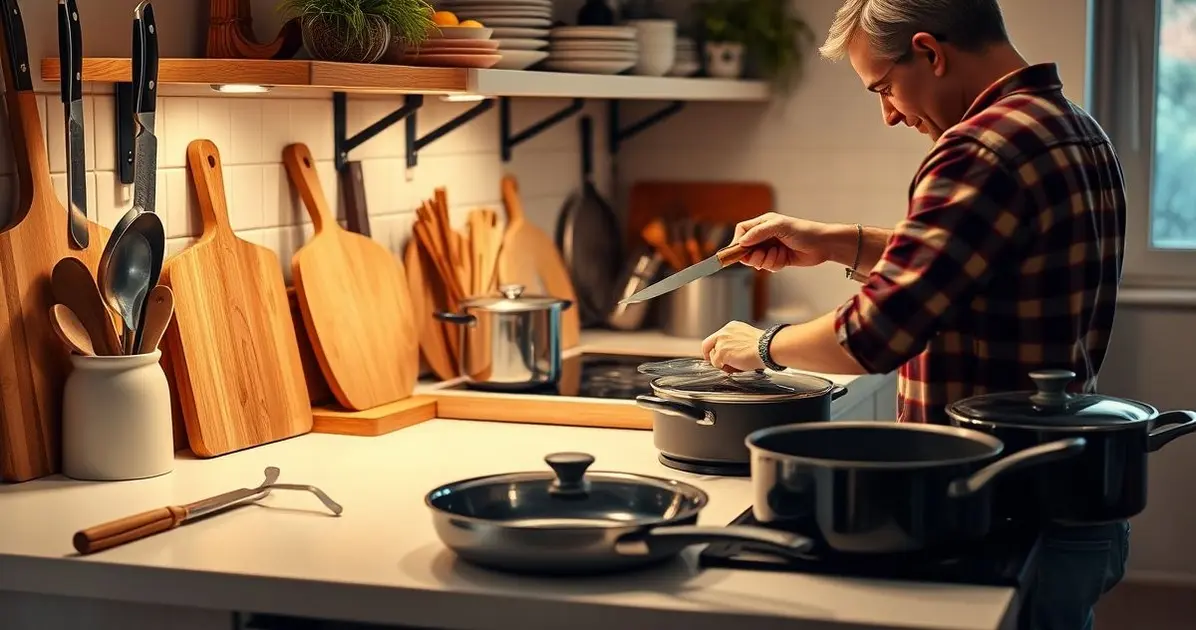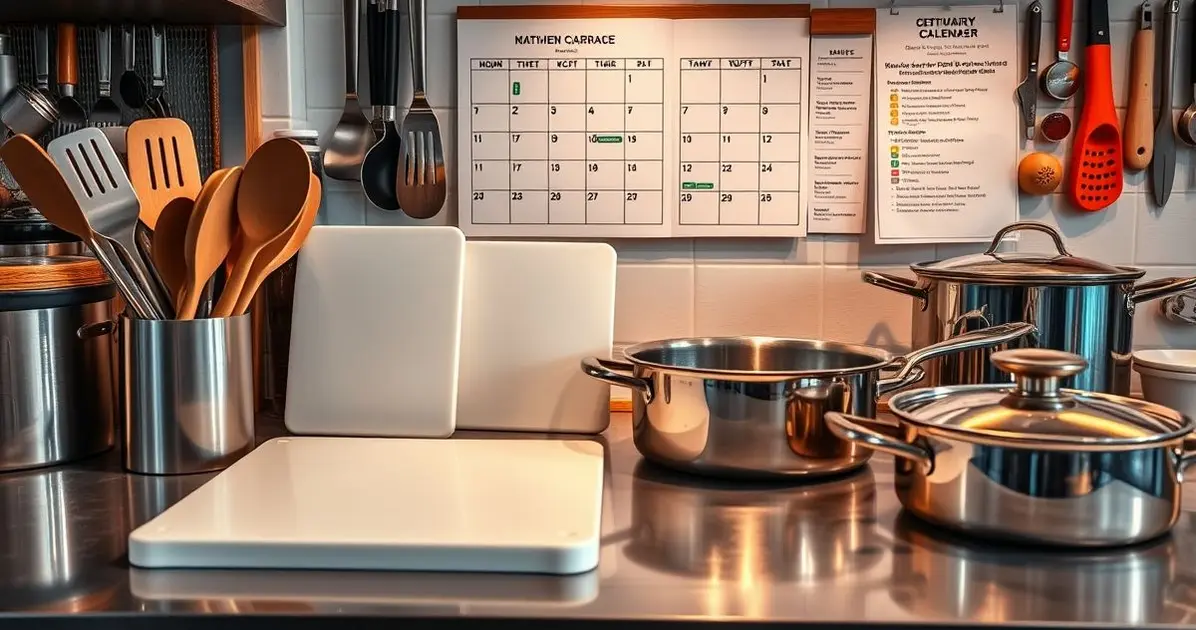Proper maintenance of cooking tools and equipment is vital for safety, efficiency, and longevity. Regular care keeps utensils sharp, pots clean, and the kitchen safe for food preparation.
What are maintenance of tools and equipments in cooking

Maintaining cooking tools and equipment involves regular cleaning, proper storage, and timely repairs. This ensures a hygienic cooking environment, enhances food quality, and prolongs the life of your kitchen tools.
Importance of Regular Cleaning
The importance of regular cleaning in the kitchen cannot be overstated. It plays a vital role in maintaining hygiene, safety, and the overall efficiency of your cooking environment. Here are the key reasons why regular cleaning is essential:
1. Prevents Foodborne Illnesses: Regular cleaning helps eliminate harmful bacteria and pathogens that can cause foodborne illnesses. By keeping surfaces, utensils, and equipment clean, you significantly reduce the risk of contamination.
2. Maintains Hygiene: A clean kitchen promotes a hygienic environment for food preparation. Regularly cleaning counters, cutting boards, and cooking tools ensures that no food residues or spills are left behind, which can attract pests and breed bacteria.
3. Enhances Food Quality: Clean tools and surfaces contribute to better food quality. Residues from previous meals can alter the taste and presentation of your current dishes. Regular cleaning ensures that each meal is fresh and flavorful.
4. Extends the Life of Tools and Equipment: Regular cleaning prevents the buildup of grease, grime, and food particles that can damage cooking tools and equipment over time. Proper maintenance through cleaning helps prolong their lifespan and ensures they perform optimally.
5. Reduces Odors: Food residues and spills can lead to unpleasant odors in your kitchen. Regular cleaning helps eliminate these odors, keeping your cooking space fresh and inviting.
6. Improves Efficiency: A clean and organized kitchen allows for greater efficiency. When your tools and surfaces are clean, you can work more quickly and effectively, reducing the time spent searching for items or dealing with messes.
7. Creates a Positive Cooking Environment: A clean kitchen fosters a positive atmosphere for cooking. It encourages creativity and enjoyment in the kitchen, making the cooking process more enjoyable.
In summary, regular cleaning is crucial for ensuring food safety, maintaining hygiene, and enhancing the overall cooking experience. By incorporating cleaning into your daily kitchen routine, you can create a safe, efficient, and pleasant environment that supports your culinary endeavors!
Proper Storage Techniques for Kitchen Tools
Proper storage techniques for kitchen tools are essential for maintaining organization, ensuring safety, and prolonging the lifespan of your equipment. Here are some effective storage techniques for kitchen tools:
1. Use Drawer Organizers: Invest in drawer organizers to keep utensils, cutlery, and small tools neatly arranged. These dividers help prevent clutter and make it easy to find what you need quickly when cooking.
2. Magnetic Strips: Install magnetic strips on walls or inside cabinet doors to hold knives and metal utensils. This method saves drawer space and keeps your tools visible and easily accessible.
3. Hanging Racks: Utilize hanging racks or pot racks to store pots, pans, and cooking tools. This approach frees up cabinet space and allows you to display your cookware as part of your kitchen decor.
4. Clear Storage Containers: Store dry ingredients like flour, sugar, and pasta in clear, labeled containers. This keeps your pantry organized and makes it easy to see when supplies are running low.
5. Lazy Susans: Incorporate lazy Susans in cabinets or on countertops to easily access spices, condiments, or other small items. This rotating storage solution maximizes space and minimizes the need to reach into the back of cabinets.
6. Under-Sink Storage: Use tiered organizers or pull-out bins under the sink to store cleaning supplies and dish soap. This area is often underutilized, and effective organization can keep it tidy and functional.
7. Cabinet Door Storage: Utilize the inside of cabinet doors for additional storage. Install hooks or small racks to hold measuring spoons, pot lids, or spices, making use of often-overlooked space.
8. Stackable Bins: Use stackable bins to store similar items together, such as baking supplies or snacks. This method keeps items organized and allows you to utilize vertical space effectively.
9. Label Everything: Consider labeling storage containers, shelves, and drawers to make it easy for everyone in the household to find and return items to their proper places. This simple practice helps maintain organization and reduces clutter.
By implementing these proper storage techniques for kitchen tools, you can create a more organized and efficient cooking environment. An organized kitchen not only makes cooking more enjoyable but also promotes a safer and more functional cooking space!

Routine Inspections for Wear and Tear
Routine inspections for wear and tear are essential for maintaining the safety and functionality of your kitchen tools and equipment. Regularly checking your tools allows you to identify issues before they become serious problems. Here are some key points to consider for routine inspections for wear and tear:
1. Schedule Regular Inspections: Set a regular schedule for inspecting your kitchen tools and equipment. This could be weekly, monthly, or quarterly, depending on how frequently you use them. Consistency is key to catching potential issues early.
2. Check for Dullness in Knives: Inspect your knives for dull blades. A dull knife can be dangerous and inefficient. If you notice that your knives are not cutting as smoothly, it’s time to sharpen them.
3. Look for Rust or Corrosion: Examine metal utensils, pots, and pans for any signs of rust or corrosion. If you find any, address it immediately by cleaning and treating the affected areas or replacing the items if necessary.
4. Inspect Wooden Tools: Check wooden utensils and cutting boards for cracks, splinters, or warping. If you find any damage, consider replacing the item to maintain safety and hygiene in your kitchen.
5. Assess Non-Stick Surfaces: For non-stick cookware, look for scratches or peeling surfaces. If the non-stick coating is damaged, it may be time to replace the cookware to ensure safe cooking.
6. Examine Appliance Cords and Connections: Regularly check the cords and connections of your kitchen appliances for fraying or damage. If you notice any issues, discontinue use until the appliance is repaired or replaced.
7. Test Functionality: Periodically test the functionality of your kitchen tools and appliances. Make sure they operate as intended and address any performance issues promptly.
8. Keep a Maintenance Log: Maintain a log of inspections and any actions taken. This will help you track the condition of your tools over time and identify patterns that may indicate when replacements are needed.
By incorporating routine inspections for wear and tear into your kitchen maintenance routine, you can ensure that your cooking tools and equipment remain safe, effective, and in excellent condition. Regular attention to your kitchen tools not only enhances food safety but also improves your overall cooking experience!
Specific Care Requirements for Different Materials
Each type of cooking tool and equipment is made from different materials, and each material has specific care requirements to ensure longevity and optimal performance. Here are the specific care requirements for different materials:
1. Stainless Steel:
- Cleaning: Use warm, soapy water and a non-abrasive sponge to clean stainless steel tools. Avoid harsh chemicals that can damage the surface.
- Maintenance: To maintain shine, you can use a mixture of vinegar and water to polish stainless steel surfaces.
- Preventing Rust: Ensure that stainless steel items are thoroughly dried after washing to prevent rust formation.
2. Cast Iron:
- Cleaning: Clean cast iron cookware with hot water and a stiff brush. Avoid using soap, as it can strip the seasoning.
- Seasoning: Regularly season your cast iron cookware with a thin layer of vegetable oil to maintain its non-stick properties and prevent rust.
- Storage: Store cast iron in a dry place, and place a paper towel between stacked pieces to absorb moisture.
3. Non-Stick Surfaces:
- Cleaning: Use mild dish soap and a soft sponge to clean non-stick cookware. Avoid abrasive scrubbers that can scratch the coating.
- Cooking Utensils: Use silicone, wood, or plastic utensils to prevent damage to the non-stick surface.
- Heat Management: Avoid using high heat when cooking with non-stick cookware, as excessive heat can degrade the non-stick coating over time.
4. Wood:
- Cleaning: Hand wash wooden utensils with warm, soapy water and dry them immediately. Avoid soaking them in water.
- Conditioning: Periodically apply food-safe mineral oil to wooden tools to keep them moisturized and prevent cracking.
- Storage: Store wooden utensils in a dry place, away from direct sunlight and heat sources to prevent warping.
5. Plastic:
- Cleaning: Clean plastic utensils with warm, soapy water. They are often dishwasher safe, but check the manufacturer’s instructions.
- Deodorizing: To remove odors, soak plastic items in a mixture of vinegar and water or use baking soda.
- Heat Sensitivity: Avoid exposing plastic utensils to high temperatures, as they can warp or melt.
By understanding and implementing these specific care requirements for different materials, you can ensure that your cooking tools and equipment remain in excellent condition, promoting food safety and enhancing your overall cooking experience!
Conclusion
In conclusion, proper maintenance and care of your cooking tools and equipment are essential for ensuring safety, efficiency, and longevity in the kitchen.
By understanding the specific care requirements for different materials—such as stainless steel, cast iron, non-stick surfaces, wood, and plastic—you can effectively preserve the quality and functionality of your tools.
Implementing regular cleaning practices, proper storage techniques, and routine inspections for wear and tear will help you maintain a safe cooking environment while extending the lifespan of your kitchen essentials.
Embracing these best practices not only enhances food safety but also improves your overall cooking experience.
Whether you’re a casual home cook or a passionate culinary enthusiast, prioritizing the care of your kitchen tools will allow you to maximize your culinary skills and create delicious meals with confidence.
Commit to these practices to ensure your kitchen remains a clean, organized, and efficient space for all your cooking endeavors!
FAQ – Frequently Asked Questions about Maintaining Cooking Tools
Bakit mahalaga ang tamang pag-aalaga ng mga kagamitan sa pagluluto?
Mahalaga ang tamang pag-aalaga upang mapanatili ang kanilang performance, kaligtasan, at pahabain ang buhay ng mga kagamitan.
Paano dapat linisin ang mga kutsilyo?
Dapat hugasan ang mga kutsilyo gamit ang mainit na tubig at mild soap, at tuyo ng maayos upang maiwasan ang kalawang.
Ano ang mga tamang paraan ng pag-iimbak ng mga kawali at pots?
Dapat itago ang mga kawali at pots sa isang maayos na paraan, gamit ang mga separator o liners upang maiwasan ang pagkakasira.
Gaano kadalas dapat suriin ang mga kagamitan sa pagluluto?
Dapat regular na suriin ang mga kagamitan para sa mga senyales ng wear and tear, at palitan ang mga sira o hindi na ligtas gamitin.
Ano ang mga tips para sa tamang pag-aalaga ng appliances?
Sundin ang mga tagubilin ng manufacturer para sa paglilinis at maintenance, at regular na linisin ang mga appliances pagkatapos gamitin.
Paano ko mapapanatiling malinis ang aking kusina?
Magsagawa ng regular na paglilinis, gumamit ng mga ligtas na cleaning agents, at sanayin ang lahat ng staff sa tamang mga pamamaraan ng paglilinis.
See more
Discover plenty of easy and delicious recipes you can make at home, from hearty dinners to indulgent desserts and wholesome breakfasts.




